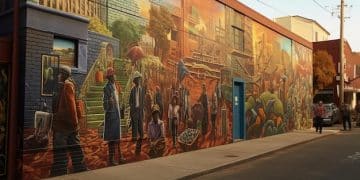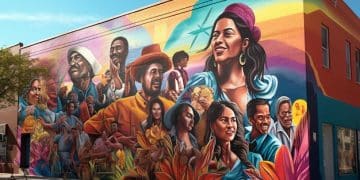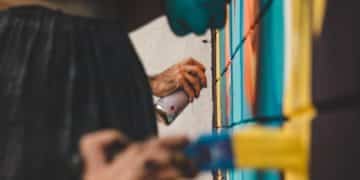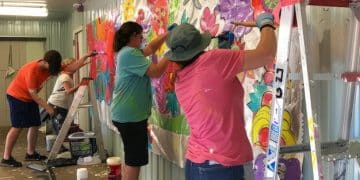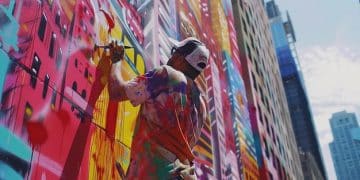Graffiti Art & Mental Health: Therapeutic Benefits for US Artists
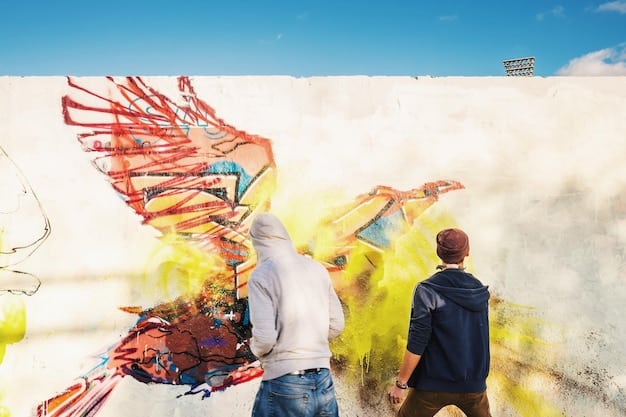
Graffiti art offers significant therapeutic benefits for US artists, providing a unique outlet for emotional expression, fostering community, and promoting mental well-being through creative engagement and urban transformation.
The urban canvas, often overlooked or misunderstood, holds a profound secret: its capacity to heal. For many, Graffiti Art and Mental Health: Exploring the Therapeutic Benefits for US Artists represents a paradigm shift, moving beyond mere aesthetics to embrace a deeper purpose. Could the vibrant strokes and bold statements found on city walls be more than just public art? Is it possible that this often-maligned art form offers a vital, unacknowledged sanctuary for the mind?
the transformative power of urban expression
Graffiti art, at its core, is a raw, uncensored form of self-expression. For US artists, this becomes particularly potent. Unlike traditional studio art, graffiti often operates outside conventional art spaces, democratizing creation and reception. This accessibility allows individuals from all walks of life, especially those who might feel marginalized or unheard, to find their voice.
The act of creating graffiti, from conceptualizing the piece to executing it on a large scale, involves intense focus and physical engagement. This immersive process can act as a powerful distraction from negative thoughts, anxieties, or depressive rumination. It channels restless energy into productive, visible output. Many artists describe entering a “flow state” where time seems to disappear, and their minds are fully absorbed in the creative act, providing a temporary but significant escape from daily stresses.
the role of anonymity and identity
In many instances, graffiti artists operate with a degree of anonymity, using tags or aliases. This anonymity can be liberating, allowing artists to express themselves without the burden of personal judgment or societal expectations often associated with their real-world identities. This separation can foster a sense of psychological safety, enabling deeper, more vulnerable emotional release through their art. It provides a platform to address difficult emotions, past traumas, or social injustices without direct personal exposure.
The creation of a unique tag or a distinctive style also contributes to identity formation. For young artists or those struggling with a sense of belonging, developing a recognizable artistic persona within the graffiti community can build self-esteem and foster a sense of purpose. This duality—anonymity coupled with a strong artistic identity—creates a complex but often healing dynamic.
- Unfiltered Expression: Graffiti provides an immediate, unrefined outlet for thoughts and feelings that might otherwise remain unarticulated.
- Flow State Immersion: The intense focus required for large-scale work induces a meditative state, reducing mental chatter.
- Identity Formation: Developing a unique artistic style and tag strengthens self-perception and personal agency.
Ultimately, the transformative power of urban expression lies in its ability to offer an accessible, often anonymous, yet deeply personal avenue for emotional processing and identity affirmation. It turns public spaces into galleries of personal narratives, contributing to both the artist’s well-being and the urban dialogue.
graffiti as a medium for emotional processing
The very act of painting, especially with the scale and physical demands of graffiti, serves as a robust mechanism for emotional processing. For US artists grappling with complex emotions, the street becomes a therapist’s couch, the spray can a conduit for catharsis. Anger, frustration, joy, or sorrow can be translated into lines, colors, and forms. This externalization of internal states is a recognized therapeutic technique, offering a safe distance from overwhelming feelings.
Imagine an artist who has experienced significant trauma. Rather than verbalizing the pain, which can be re-traumatizing, they might pour that raw emotion into a melancholic mural, using dark hues and distorted figures. The physical exertion involved in climbing, reaching, and spraying also expends built-up emotional energy, providing a release similar to intense physical exercise but with an added creative dimension. This kinesthetic engagement makes the processing more holistic, involving both mind and body.
channeling negative emotions into positive output
Graffiti’s often rebellious nature can paradoxically be one of its greatest therapeutic strengths. For individuals who carry feelings of resentment, rebellion against authority, or a sense of injustice, graffiti provides a non-destructive way to channel these powerful negative emotions. Instead of self-harm or destructive behaviors, the artist pours intense feelings into a visible statement. This redirection of energy into a creative act transforms what could be destructive impulses into a form of public dialogue.
The feeling of agency that comes from making a mark on the urban landscape, even if temporary, can be incredibly empowering. It counters feelings of helplessness and voicelessness. For someone feeling invisible in society, a vibrant piece of graffiti is a declaration: “I exist, I have something to say, and I am here.” This contributes to a sense of control and efficacy over one’s environment and emotional state.
- Cathartic Release: The physical act of painting allows for the release of pent-up emotions and stress.
- Symbolic Representation: Complex feelings can be translated into visual metaphors, making them more manageable.
- Empowerment Through Visibility: Making a public statement helps counteract feelings of insignificance and helplessness.
By engaging in this externalization and symbolic representation, graffiti artists can gain new perspectives on their emotional landscapes, finding solidarity and validation within the subculture.
community, connection, and belonging
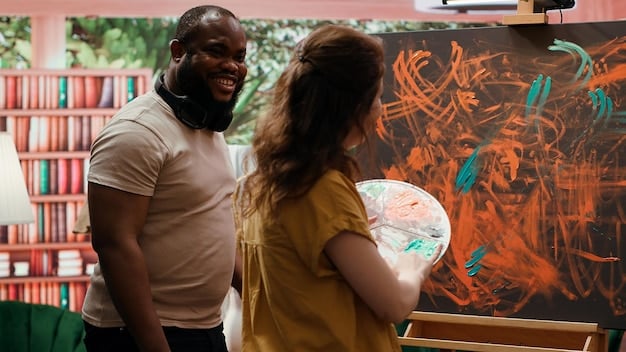
Beyond individual expression, the graffiti community itself plays a crucial, often underestimated, role in mental well-being. For many, particularly during formative years or periods of social isolation, finding a community that shares a passion and understanding is paramount. The graffiti scene, with its shared language, unspoken rules, and mutual respect for talent, offers a strong sense of belonging that can counteract feelings of loneliness or alienation.
Artists often collaborate on pieces, share techniques, and discuss concepts, fostering strong bonds. This shared pursuit builds trust and camaraderie. In a world where genuine connection can feel elusive, these relationships become a vital support system, providing informal peer therapy and a sense of collective identity. The exchange of ideas and the recognition of skills within this subculture can significantly boost an artist’s self-esteem and reduce feelings of inadequacy.
mentorship and shared wisdom
Within the graffiti community, informal mentorship is common. Experienced artists often guide newer ones, sharing practical skills, safety tips, and ethical considerations. This intergenerational exchange goes beyond technical advice; it often includes shared life experiences, coping strategies, and wisdom. For young artists lacking parental guidance or positive role models, these mentor figures within the art scene can provide invaluable support and direction, contributing positively to their mental development and resilience.
These connections often transcend the art itself. The shared experiences of navigating the urban environment, facing public scrutiny, and creating under pressure forge unique bonds. This collective identity, rooted in a mutual commitment to their craft, provides a powerful antidote to the pressures of mainstream society and helps artists feel understood and valued for their unique contributions.
- Enhanced Social Bonds: Collaborative projects and shared experiences create strong, supportive friendships.
- Sense of Belonging: Being part of a niche community combats feelings of loneliness and isolation.
- Skill and Wisdom Exchange: Mentorship within the community provides practical and emotional guidance.
The social fabric of the graffiti world creates a resilient network, fostering a sense of shared purpose and offering an informal system of care that benefits the mental health of its participants.
graffiti as stress reduction and cognitive enhancement
The creative process, particularly in a demanding art form like graffiti, is inherently stress-reducing and cognitively stimulating. The mindful engagement required for planning and executing a piece—from sketching designs to choosing colors and managing paint flow—activates various parts of the brain. This mental workout can improve problem-solving skills, spatial awareness, and fine motor coordination. For individuals struggling with attention issues or cognitive fog, these activities provide a low-stakes, high-engagement form of cognitive therapy.
The physical aspects, such as climbing, stretching, and precision movements with a spray can, also contribute to overall well-being. This physical activity releases endorphins, natural mood elevators, further enhancing the therapeutic effect. The combination of mental focus and physical exertion creates a holistic pathway to reducing stress and improving cognitive function.
the meditative nature of repetitive tasks
While graffiti involves grand gestures, it also comprises many repetitive tasks: shaking cans, pressing nozzles, filling in outlines, and blending colors. These repetitive actions can induce a meditative state, similar to that achieved through knitting, drawing, or other crafts. The mind settles into a rhythm, allowing for a quiet reflection and a temporary respite from anxious thoughts. This focus on the present moment, on the physical action of creating, helps ground the artist and break cycles of rumination.
Moreover, the act of seeing an idea materialize from concept to a tangible, visible work on a wall offers a profound sense of accomplishment. This tangible success validates effort and creativity, boosting self-efficacy. For those who may feel a lack of control in other areas of their lives, the ability to transform a blank surface into a vibrant artwork can be incredibly empowering, reinforcing a positive self-image and providing a sense of mastery.
- Cognitive Benefits: Enhances problem-solving, spatial reasoning, and fine motor skills.
- Stress Alleviation: The creative flow state and physical activity reduce anxiety levels.
- Mindfulness Practice: Repetitive tasks foster a meditative state, promoting mental calm.
The multi-faceted engagement involved in graffiti art provides a compelling case for its role in stress reduction and cognitive stimulation, proving that art in unexpected places can foster significant mental gains.
challenges and stigmas: navigating the landscape
Despite its therapeutic potential, graffiti art, particularly in the US, continues to face significant challenges and pervasive stigmas. It is frequently conflated with vandalism, often leading to arrests, fines, and public condemnation. This societal disapproval can contribute to further marginalization for artists who are already vulnerable, counteracting some of the positive mental health benefits derived from the art itself.
The risk of legal repercussions creates a constant underlying stress for many artists. The need to create covertly, often at night, in isolated locations, adds to the pressure. This environment can, for some, exacerbate anxiety rather than alleviate it. Therefore, while the act of creation is therapeutic, the external circumstances surrounding it can introduce new stressors, highlighting the complex relationship between the art form and its societal perception.
the role of public perception and policy
Public perception heavily influences how graffiti is viewed, ranging from outright condemnation to grudging admiration. Where policies are punitive, the mental well-being benefits are often overshadowed by the risks. Conversely, cities that embrace street art, establishing legal walls or commissioning murals, provide a safer, more positive environment for artists. This shift in policy can transform a potentially stressful activity into a fully legitimate and recognized form of artistic expression, allowing its therapeutic benefits to flourish without the fear of negative consequences.
Education about the nuanced nature of street art and its distinction from mere tagging or defacement is crucial. Promoting understanding that not all urban mark-making is malicious, and that some forms of graffiti are indeed powerful artistic and social commentaries, can help alleviate the stigma. When artists are able to operate in sanctioned spaces, the stress associated with criminality diminishes, allowing the mental health benefits to take center stage, fostering a healthier overall creative environment.
- Legal Risks: The threat of arrest and fines adds significant stress, counteracting therapeutic gains.
- Societal Stigma: Negative public perception can marginalize artists and invalidate their creative outlet.
- Policy Impact: Supportive urban policies can transform the art into a recognized, less stressful pursuit.
Addressing these challenges through enlightened policy and increased public understanding is vital to fully unlock graffiti’s therapeutic potential for US artists, allowing them to create freely and heal openly.
advocacy and future directions for graffiti and mental health
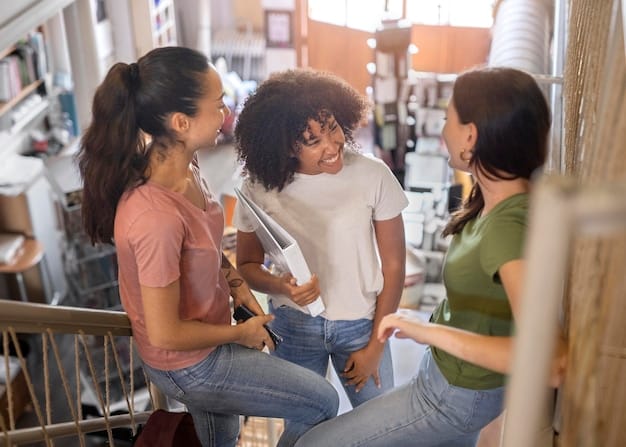
The growing recognition of art therapy and creative expression in mental health provides a strong foundation for advocating for graffiti art’s therapeutic role. Future directions must focus on bridging the gap between the perceived “urban blight” and the actual potential for healing and community building that graffiti offers. This requires a multi-pronged approach involving urban planners, mental health professionals, community organizers, and artists themselves.
Expanding sanctioned spaces for graffiti art, such as legal walls, community murals, and public art initiatives, is a critical step. These spaces not only mitigate legal risks but also legitimize the art form, allowing artists to create without fear. When graffiti is integrated into urban planning, it transforms from a clandestine activity into a celebrated contribution to the cultural landscape, promoting well-being openly and creatively.
integrating graffiti into therapeutic programs
A significant future direction involves formally integrating graffiti art into therapeutic and rehabilitative programs, particularly for at-risk youth, veterans, or individuals overcoming addiction in the US. Art therapists could explore incorporating graffiti techniques and motifs to help clients process trauma, express difficult emotions, and develop a sense of identity and agency. The non-verbal, expressive nature of graffiti makes it particularly suitable for individuals who struggle with verbal communication of their inner worlds.
Workshops focusing on street art fundamentals, combined with group therapy sessions, could provide a powerful intervention. Such programs would not only teach artistic skills but also foster positive social connections, build self-esteem, and provide a healthy outlet for expression. By embracing graffiti as a valid therapeutic modality, mental health professionals can tap into a powerful, accessible, and culturally relevant form of healing for diverse populations.
- Sanctioned Spaces: Creating more legal walls and public mural opportunities reduces risk and increases acceptance.
- Therapeutic Integration: Incorporating graffiti into formal art therapy programs for specific populations.
- Community Engagement: Fostering dialogue between artists, policymakers, and communities to shift perception.
The path forward for graffiti art and mental health lies in fostering understanding and creating environments where its profound therapeutic benefits can be harnessed for the well-being of US artists and the communities they enrich.
| Key Benefit | Brief Description |
|---|---|
| 🎨 Emotional Outlet | Graffiti offers a non-verbal means to process and express complex emotions, fostering catharsis. |
| 🤝 Community & Belonging | Artists find connection, shared experiences, and mentorship within the graffiti subculture. |
| 🧠 Cognitive & Stress Relief | The creative process induces flow states, reduces anxiety, and enhances problem-solving skills. |
| 💪 Empowerment & Identity | Making a public mark builds agency, self-esteem, and strengthens artistic identity. |
frequently asked questions about graffiti art & mental health
▼
Graffiti art provides a unique visual language for emotions. Artists can translate complex feelings like anger, joy, or sadness into colors, shapes, and figures directly onto a large canvas. This externalization allows for a release and processing of emotions without needing verbal articulation, making it accessible even when words fail.
▼
While not a formal art therapy, the act of creating graffiti shares many therapeutic benefits. It fosters a “flow state” that reduces stress, provides a sense of accomplishment, and offers a safe outlet for channeling difficult emotions. The physical exertion also releases endorphins, contributing to overall mood improvement and mental clarity.
▼
The graffiti community offers a vital sense of belonging for artists, combating feelings of isolation. Shared experiences, collaborations, and informal mentorship foster strong social bonds and mutual support. This collective identity and shared passion significantly contribute to increased self-esteem and a positive self-perception among participants.
▼
Absolutely. The planning, sketching, and execution of graffiti pieces demand high levels of cognitive engagement. This creative process enhances problem-solving skills, spatial reasoning, and fine motor coordination. The repetition of techniques can also induce a meditative state, improving focus and reducing mental clutter for artists.
▼
Overcoming stigma requires promoting legal graffiti walls, commissioning public murals, and educating the public on its artistic and therapeutic value. By distinguishing between vandalism and legitimate street art, and integrating it into community and therapeutic programs, society can transform perception, allowing its profound mental health benefits to flourish freely.
conclusion
In exploring Graffiti Art and Mental Health: Exploring the Therapeutic Benefits for US Artists, it becomes clear that this vibrant, often misunderstood, art form is far more than just paint on a wall. It is a powerful conduit for emotional expression, a fertile ground for community building, and a robust tool for cognitive and stress reduction. Despite the enduring stigmas and legal challenges, the profound well-being advantages for those who wield the spray can are undeniable. By shifting perceptions, fostering understanding, and promoting accessible, sanctioned spaces, we can unlock the full therapeutic potential of graffiti art, recognizing its crucial role in fostering mental resilience and creative healing within American urban landscapes.

